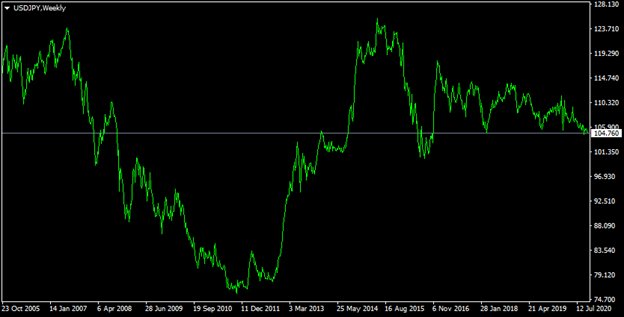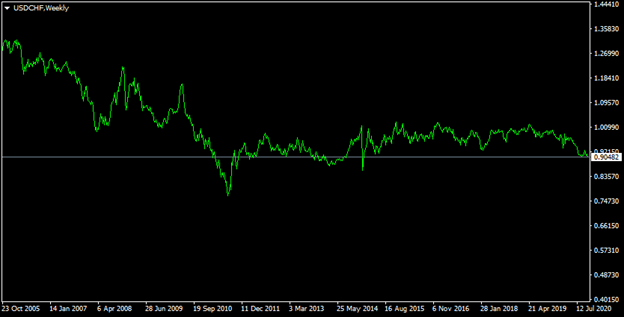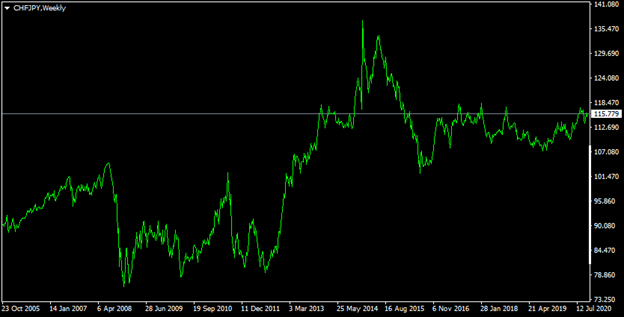It is a well-known fact that the majority of currencies, representing advanced economies, have an average 2% to 3% inflation rate, explains Konstantin Rabin of fxpro.com.
In fact, nearly all of the central banks managing those currencies have adopted some specific targets for the consumer price index and they adjust their policies on a regular basis in accordance with those mandates.
However, this does not mean that all major currencies have their inflation rates at 2% or 3%. There are some currencies that experienced near-zero rate inflation for decades. In fact, there were cases when those developed economies have experienced some lengthy deflationary periods as well.
We have two examples of such currencies among the major currencies in the forex market. Those are the Japanese yen and the Swiss franc. In the case of the former, this process began way back in the late 1990s. During the last 25 years, the near-zero inflation rates in the country were followed by periods of deflation.
There was a major effort in 2012 to roll back the tide of this deflationary spiral, but since the outbreak of the COVID-19 pandemic, it became apparent that this strategy might eventually fail. The Bank of Japan responded to this problem by lowering its key interest rate down to -0.1%. However, many economists and financial commentators do acknowledge that the negative interest rates can have a lot of unintended consequences.
On the other hand, Switzerland has experienced this situation in the aftermath of the 2008 financial crisis. The reality is that the price levels in the country in 2020 is essentially the same as in 2008. This means that the price levels in Switzerland remained flat for the last 12 years. In response to that, the Swiss National Bank went even further and reduced its key interest rate all the way down to -0.75%. However, this move did little to boost the inflation rate.
Short Term Effects of Deflation
When it comes to the effects of the deflation on currency exchange rates, it is important to point out that there are both short- and long-term implications of this process. It is not too difficult to guess the short-term impact of the deflation on the given currency.
Since both the Bank of Japan and the Swiss National Bank are targeting the 2% inflation rate, it is not surprising that they have reacted to deflation by cutting rates dramatically. In fact, since 2016, both of those central banks have adopted the policy of the negative interest rates.
As a result, the short-term impact of those decisions was the depreciation of the Japanese yen and the Swiss franc. The reason for this is simple, the policy of negative interest rates strongly discourages savers from opening and holding deposits in Swiss francs and in Japanese yen.
Now, here it is important to clarify that the policy of negative interest rate does not mean that all depositors have to pay money to keep their savings accounts open. What happens here is that there is a certain threshold under which people do not have to pay any interest. For example, in Switzerland, most banks do not charge any interest on deposits, which are below 250,000 CHF. However, if savers exceed this limit, then they have to pay a 0.75% interest rate on the excess amount.
Therefore, it goes without saying that this creates a strong incentive for wealthy investors to convert their Swiss francs into US dollars, or other major currencies, where they do not have to pay any interest to the bank, regardless of the size of the deposit.
In addition to that, it is important to point out that this policy of negative interest rates encourages the forex traders to use the Japanese yen and the Swiss franc as funding currencies for carry trades. In order words, there are thousands of traders who have borrowed in those two currencies in order to invest in higher-yielding currencies. As a result, the short-term impact of deflation is the depreciation of the currency.
Long-Term Impact of Deflation on Currency Exchange Rates
Since the negative interest rate policy makes the Japanese yen and the Swiss franc unattractive currencies for traders, investors, and savers, then many people might conclude that deflation is bad for the currency in the long term as well. We can check whether or not this is the case, by taking look at the USD/JPY chart, which covers the price actions of this currency pair for the last 15 years:

As we can see from the image above, during the late 2005, the USD/JPY pair was trading close to 115 level. Due to some number of rate hikes, authorized by the US Federal Reserve, the US dollar has made some notable gains against the Japanese yen, with the pair eventually rising to 124 level by the middle of 2007.
However, here it is worth remembering that during the second half of 2007 the US Federal Reserve started reversing the policy and cutting the federal funds rate on several occasions. As a result, the US dollar has started losing ground against some other major currencies, including the Japanese yen.
In fact, when the US dollar started to rally against the euro and the British pound during the second half of 2008, this was not the case with the USD/JPY currency pair, which simply kept up with its long-term depreciation.
The fact of the matter was that this long-term downward trend for the USD/JPY pair has persisted well into 2011. By that time the USD/JPY currency pair had dropped all the way down to 76 level. Actually, it was at that point when the Bank of Japan decided to step in and essentially declare 75 level as a floor for the pair. This essentially means that if JPY has appreciated further and USD/JPY went below the 75 mark, then the Bank of Japan would intervene to weaken the yen and push the pair back to the 75 level.
In addition to that from 2012, the Bank of Japan has increased its inflation target to 1% to 2%, coupled with the introduction of a massive quantitative easing program. In the short term, this policy has paid off. The USD/JPY has made some rapid gains, eventually rising to 125 level by 2015. However, this show of strength did not persist for long, as after that point the pair resumed its long-term decline, eventually dropping down to 105 level by October 2020.
So at this point, there is a very logical question: if interest rates in Japan are so low, then how can we explain this sort of resilience the currency has against the US dollar and other major currencies?
Well, the fact of the matter is that according to the purchasing power parity theory, also known as the PPP, in the long term, currencies with lower inflation rates tend to appreciate against the currencies with higher inflation rates. Therefore, in the long term having flat price levels and occasional periods of deflation can be beneficial for the currency.
This theory is further supported by another real life example. Here we can take a look at the USD/CHF chart:

As we can see from the above diagram, the USD/CHF pair was trading near the 1.29 level during the late 2005. In the course of the subsequent years, the pair was in a downward trend, eventually falling all the way down to the 0.76 level by 2011.
However, after this period, thanks to the 1.20 floor for EUR/CHF rate, introduced by the Swiss National Bank the pair has stabilized and recovered. The above mentioned floor did eventually collapse in 2015. However, at the same time, the Swiss National Bank also decided to drop its key interest rate all the way down to -0.75%. So this decision has weakened the Swiss franc to a certain extent and kept the exchange rate of the USD/CHF pair more or less stable.
Yet, as the US Federal Reserve has once more returned to a near-zero interest rate policy in response to the outbreak of the COVID-19 pandemic, the USD/CHF has resumed its long-term downward trend. As a result of this development by October 2020, the pair has already dropped down to the 0.91 level and so far there is little reason to believe that this will necessarily mark the end of this downward trend.
Japanese Yen vs. Swiss Franc
As we have seen from the previous charts and examples, in the long term, the Japanese yen and the Swiss franc are indeed one of the strongest performing major currencies in the market. This is not because their respective central banks want to achieve this, but instead, the low inflation rate those currencies have led to their long-term appreciation. In order words, the Japanese yen and Swiss franc benefit from the long-term gains, because they are better stores of value, than many other major currencies.
However, at this stage, the next logical question is: which currency has performed better in the market during the last few years? Well, in order to respond to this question accurately, we can take a look at this daily CHF/JPY chart:

As we can observe from the above diagram, in the autumn 2005, the CHF/JPY pair was trading close to 90 level. During the subsequent years, the Swiss currency has made some notable gains, eventually rising to 104 level by the summer of 2008. However, in the aftermath of the 2008 financial crisis, the Japanese yen has erased all of its recent losses, with the CHF/JPY pair dropping all the way down to 79 level by 2011.
However, this has marked an end to the depreciation of the Swiss franc. Since 2012 the Swiss currency has made consistent gains against the Japanese yen. As a result, by October 2020, the CHF/JPY pair now trades close to 115 level, which is actually a considerably higher level than at the beginning of this period.
So generally speaking, before 2011, the Japanese yen had an edge and made some gains against the Swiss franc. However, as a result of the aggressive easing policies by the Bank of Japan, then yen started to lose ground after 2012. So this suggests that during the last eight years, the Swiss franc has performed better than the Japanese yen. However, this does not necessarily mean that those trends will persist indefinitely. This will depend on the future policies of the Swiss National Bank and Bank of Japan, as well as the performance of those two economies.
This does not necessarily mean that currencies affected by deflationary periods will always make some massive gains against other currencies. One thing we can take note of here is that as those currencies get stronger, their respective central banks become more desperate to halt the appreciation of their currencies. We have already seen that both the Swiss National Bank and the Bank of Japan have introduced central floors for the exchange rates.
Consequently, it is not out of line to suggest that if the current trends persist at some point in the future those central banks might introduce other floors for the exchange rates and even resort to more aggressive easing measures. Consequently, taking a long position for those currencies during an extended period of time can be quite risky.
In addition to that, it is also worth pointing out that holding long positions with those currencies can be not only risky but expensive as well. This is because, when traders buy lower-yielding currencies against higher-yielding currencies, they have to pay a daily interest to the broker. This is also known as rollover or swap.
Now, this might represent a small fee for one day. However, if traders keep such positions open for extended periods of time, then those types of fees can certainly add up to a considerable amount. So, this is something to keep in mind when making the trading decisions with such currencies as the Japanese yen and the Swiss franc.
By Konstantin Rabin of fxpro.com - an award-winning retail FX brokerage.




















